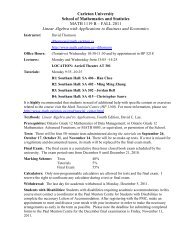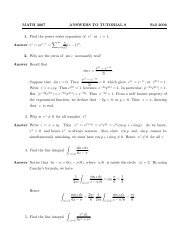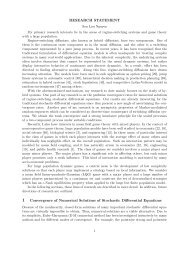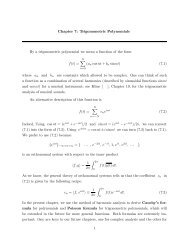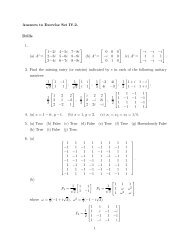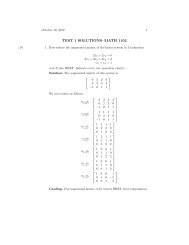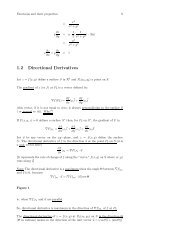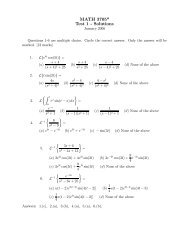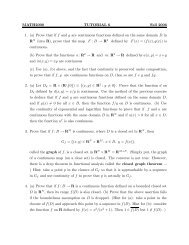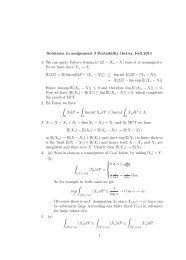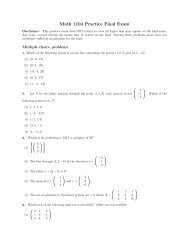CHAPTER II DIMENSION In the present chapter we investigate ...
CHAPTER II DIMENSION In the present chapter we investigate ...
CHAPTER II DIMENSION In the present chapter we investigate ...
Create successful ePaper yourself
Turn your PDF publications into a flip-book with our unique Google optimized e-Paper software.
for Grassmann). The n-dimensional projective space modeled on V , denoted by P [V ]<br />
here, is G1(V ), <strong>the</strong> set consisting of all 1-dimensional subspaces of V . Thus a point in<br />
P [V ] is just a 1–dimensional subspace. For a nonzero vector v in V , denote by [v] <strong>the</strong><br />
1–dimensional subspace spanned by v, which re<strong>present</strong>s a point in P [V ]. Thus <strong>we</strong> may<br />
write<br />
P [V ] = G1(V ) = {[v] | v ∈ V, v = 0}.<br />
Notice that two points [u] and [v] in P [V ] coincide if and only if u = av for some scalar<br />
a = 0. Given M ∈ G2(V ) (that is, M is a 2–dimensional subspace of V ), denote by [M]<br />
<strong>the</strong> set of all points [v] in P [V ] with v ∈ M:<br />
[M] = {[v] ∈ P [V ] | v ∈ M}.<br />
<strong>In</strong> o<strong>the</strong>r words, [M] is <strong>the</strong> set of all 1–dimensional subspaces contained in M. A set of<br />
<strong>the</strong> form [M] with M ∈ G2(V ) is called a (projective) line. Now <strong>the</strong> statement “given<br />
two distinct points in a projective space, <strong>the</strong>re is a unique line passing <strong>the</strong>m” in projective<br />
geometry can be rephrased as “given two distinct 1–dimensional subspaces, <strong>the</strong>re is a<br />
unique 2–dimensional subspace containing both of <strong>the</strong>m” in linear algebra, which is more<br />
or less transparent. <strong>In</strong> <strong>the</strong> same way <strong>we</strong> define a (projective) plane in P [V ] to be [M] =<br />
{[v] ∈ P [V ] | v ∈ M}, where M ∈ G3(V ).<br />
When V = F n+ 1 , <strong>we</strong> write P n (F) or simply P n for P [V ]. For a nonzero vector<br />
x = (x0, x1, . . . , xn) in F n+ 1 , <strong>we</strong> write [x0 : x1 : x2 : · · · : xn] for [x]; (<strong>the</strong> numbers<br />
x0, x1, . . . , xn are called <strong>the</strong> homogeneous coordinates of <strong>the</strong> point). Notice that, for any<br />
scalar a = 0, [ax0 : ax1 : · · · : axn] = [x0 : x1 : · · · : xn]. We identify a point<br />
(x1, x2, . . . , xn) in F n with <strong>the</strong> point [1 : x1 : · · · : xn] in <strong>the</strong> projective space P n , called<br />
an ordinary point. Notice that, when x0 = 0, [x0 : x1 : · · · : xn] is an ordinary point<br />
because it can be rewritten as [1 : x1/x0 : · · · : xn/x0]. Thus a non–ordinary point is of<br />
<strong>the</strong> form [0 : x1 : · · · : xn]; it is called a point at infinity.<br />
Now <strong>we</strong> give a closer look at <strong>the</strong> case n = 2 and F = R. <strong>In</strong> this case P 2 is called <strong>the</strong><br />
real projective plane. Let us consider a line<br />
ax + by = c (C1)<br />
in F 2 . Write x = x1/x0 and y = x2/x0. Then <strong>we</strong> have a(x1/x0) + b(x2/x0) = c, or<br />
a0x0 + a1x1 + a2x2 = 0, (C2)<br />
where a0 = −c, a1 = a, a2 = b are not simultaneously zero. When [x0 : x1 : x2] is an<br />
ordinary point on <strong>the</strong> line given by (C2) in <strong>the</strong> projective plane, it also re<strong>present</strong>s a point<br />
30



